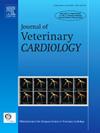Efficacy and safety of different antiarrhythmic protocols used for rate control in dogs with secondary atrial fibrillation
IF 1.3
2区 农林科学
Q2 VETERINARY SCIENCES
引用次数: 0
Abstract
Introduction/Objectives
Studies comparing the effects of antiarrhythmic protocols used for rate control in dogs with secondary atrial fibrillation (AF) are currently limited; therefore, this study aimed to report detailed data on the efficacy and therapy-related side-effects (TRSEs) of different antiarrhythmic protocols in dogs with secondary AF.
Animals, Materials, and Methods
Dogs with secondary AF treated with combination therapy with diltiazem and digoxin (CTDilt+Digox), diltiazem monotherapy (MTDilt), digoxin monotherapy (MTDigox), or amiodarone monotherapy (MTAmiod) were retrospectively evaluated. Signalment, clinical, diagnostic, therapeutic, and outcome data were retrieved. Electrocardiographically, antiarrhythmic efficacy was defined by a reduction in the mean heart rate on Holter monitoring ≤125 beats/minutes. Statistical analysis was performed to compare selected data, including the rate of efficacy and TRSEs as well as the median survival time, between dogs treated with different antiarrhythmic protocols.
Results
Fifty-four dogs were included, with 28 receiving the CTDilt+Digox and 26 receiving monotherapies (MTDigox = 16; MTDilt = 5; MTAmiod = 5). The efficacy rate documented in dogs treated with CTDilt+Digox was significantly higher than that observed in dogs from the composite monotherapy group (i.e., MTDilt+MTDigox+MTAmiod) (P=0.048). The rate of TRSEs documented in dogs treated with CTDilt+Digox was similar to that observed in dogs from the composed monotherapy group (P=0.129). The median survival time documented in dogs treated with CTDilt+Digox was significantly longer than that observed in dogs of the MTDigox group (P=0.01).
Discussion
In dogs with secondary AF we included, CTDilt+Digox was well tolerated and provided clinically relevant benefits compared to the use of a single antiarrhythmic drug.
Limitations
Retrospective design; heterogeneous sample size of categories analyzed; clinicopathological data available for many, but not all, dogs.
Conclusions
Our findings support the indication to generally consider CTDilt+Digox as a first-line antiarrhythmic treatment in dogs with secondary AF.
用于控制继发性心房颤动犬心率的不同抗心律失常方案的有效性和安全性
导言/目的目前,比较用于继发性心房颤动(房颤)犬心率控制的抗心律失常方案效果的研究非常有限;因此,本研究旨在报告继发性房颤犬中不同抗心律失常方案的疗效和治疗相关副作用(TRSE)的详细数据。动物、材料和方法回顾性评估了接受地尔硫卓和地高辛联合疗法(CTDilt+Digox)、地尔硫卓单药疗法(MTDilt)、地高辛单药疗法(MTDigox)或胺碘酮单药疗法(MTAmiod)治疗的继发性房颤犬。对信号、临床、诊断、治疗和结果数据进行了检索。在心电图上,抗心律失常疗效的定义是 Holter 监测的平均心率降低≤125 次/分钟。结果54只犬接受了治疗,其中28只接受了CTDilt+Digox疗法,26只接受了单一疗法(MTDigox = 16;MTDilt = 5;MTAmiod = 5)。接受 CTDilt+Digox 治疗的狗的有效率明显高于单一疗法复合组(即 MTDilt+MTDigox+MTAmiod)的狗(P=0.048)。接受CTDilt+Digox治疗的狗的TRSE发生率与单一疗法组合组的狗相似(P=0.129)。讨论在我们纳入的继发性房颤患犬中,CTDilt+Digox的耐受性良好,与使用单一抗心律失常药物相比具有临床相关性优势。局限性回顾性设计;所分析类别的样本量不一致;许多(但不是所有)犬只的临床病理学数据可用。
本文章由计算机程序翻译,如有差异,请以英文原文为准。
求助全文
约1分钟内获得全文
求助全文
来源期刊

Journal of Veterinary Cardiology
VETERINARY SCIENCES-
CiteScore
2.50
自引率
25.00%
发文量
66
审稿时长
154 days
期刊介绍:
The mission of the Journal of Veterinary Cardiology is to publish peer-reviewed reports of the highest quality that promote greater understanding of cardiovascular disease, and enhance the health and well being of animals and humans. The Journal of Veterinary Cardiology publishes original contributions involving research and clinical practice that include prospective and retrospective studies, clinical trials, epidemiology, observational studies, and advances in applied and basic research.
The Journal invites submission of original manuscripts. Specific content areas of interest include heart failure, arrhythmias, congenital heart disease, cardiovascular medicine, surgery, hypertension, health outcomes research, diagnostic imaging, interventional techniques, genetics, molecular cardiology, and cardiovascular pathology, pharmacology, and toxicology.
 求助内容:
求助内容: 应助结果提醒方式:
应助结果提醒方式:


